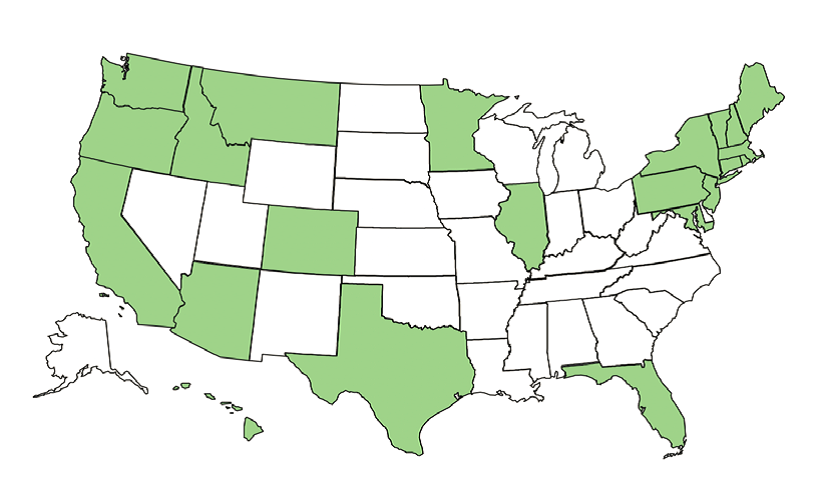Director's Note
To get ready for winter, squirrels store acorns at this time of year. Likewise, NEEP has also been getting ready for winter and looking ahead to 2020. This means thinking about ways to help support the states in our region to develop or implement ambitious decarbonization policies, integrate energy efficiency with other distributed resources, and tackle energy optimization. From a program and policy perspective, energy optimization means using—and not using—energy in the built environment to maximize benefits for the climate and for people. It includes a heavy focus on whole-building treatments and meter-based savings. Evaluation, measurement, and verification play essential supporting roles for all of these activities. In this newsletter, we briefly review how NEEP is helping with the following EM&V-related activities: cost-effectiveness frameworks, development of load profile data, incorporating M&V2.0 tools into program implementation, and developing new metrics.
Meanwhile, if you missed some of our recent events, here are links to the slides and webinar recordings:
- Is Pay for Performance Performing? (October 11, 2019)
- Introducing End Use Load Profiles Study – U.S.A. and Northeast (October 24)
- Strategic Energy Management (SEM) Workshop (Albany, NY, November 14)
Please contact Elizabeth Titus for more information on NEEP’s EM&V activities and related updates.
Facelifts for Cost-Effectiveness
Energy efficiency is not the only resource that is, in some way, supported on behalf of electric and gas customers. Demand response, PV, and behind-the-meter storage are among the other distributed energy resources (DERs) that are elements of utility and state energy plans. Taken together, these resources hold promise as strategies to help achieve environmental goals and resiliency as well as helping meet capacity needs and delivering other benefits.
Cost effectiveness is a key driver of planning, and there is concern that the full value of these resources is understated. One of the challenges for states is how to plan for – and later evaluate – these resources in an integrated fashion. Whether the task involves designing non-wires alternative projects, examining a customer’s or site’s impacts where multiple DERs are at play, or planning for the implementation of strategic electrification, it makes sense to approach cost-effectiveness comprehensively. New York is tackling this through “value stacking”, but to date, the energy community as a whole lacks a cohesive framework that analyzes cost-effectiveness of DERs in an integrated way.
Help is on the way. Building on its experience with the National Standard Practice Manual, E4TheFuture is working with an advisory committee (which includes NEEP) and consultants to scope an expansion of the NSPM cost-effectiveness framework that will provide national guidance on cost-effectiveness of DERs beyond energy efficiency – individually and in combinations.
This year, within our region both New Hampshire and Connecticut have been especially active in conversation about cost-effectiveness frameworks. The NH Public Utility Commission (PUC) staff filed its recommendations for cost-effectiveness testing after working through the National Standard Practice Manual process. PUC staff recommends using the Granite State Test, which include participant and societal impacts. Staff also recommends the PUC adopt the Utility Cost Test and Secondary Granite State Cost Test as secondary tests for energy efficiency cost-effectiveness screening, requiring utilities to perform and file both alongside the primary test. The consideration of energy optimization through fuel-switching and consideration of a net MMBtu savings goal for electric programs is also included in the recommendations.
Connecticut regulators are working to pin down the true value of distributed energy resources. Public act number 19-35, amended earlier this year, called for regulators to submit a study on the value of DERs to the General Court by July 1, 2020. In its proceeding (Docket No. 19-06-29), the Connecticut Public Utilities Regulatory Authority (PURA) is considering DERs generally and is looking at a range of benefits — economic, environmental, health, and grid-related. Relatively little precedent existed to guide Connecticut regulators, but the scope of the expanded version of the NSPM will hopefully help address the challenge that Connecticut and other states face in planning for and optimizing DERs.
Filling Data Gaps: The National and Regional Perspective on End Use Load Profiles
Part of the solution to meeting the increasingly ambitious energy goals set by states and utilities is improving electric grid flexibility, and part of the solution to more flexibility is more and better information about electricity end-use load profiles (EULP). EULPs quantify how and when energy is used. Optimally managing the grid and buildings as grid assets that shift activities to different times of the day depends on having accurate, accessible, geographically-specific load profiles. High quality EULPs are necessary to assess utility-avoided costs and customer participation in time-varying rates, including demand-based rate options. But the first step is knowing what materials we have available and what (more) information is needed.
NEEP is involved in studies that are addressing these questions. We are just beginning work supported by the Massachusetts Clean Energy Council (MA CEC) and the New York State Energy Research and Development Authority (NYSERDA) to drill down regionally to determine what more EULP data is needed to support energy planning in these states. Please contact Elizabeth Titus if you are interested in participating in a Northeast Regional EULP Advisory Committee. This work builds on a related national study supported by the U.S. Department of Energy. NEEP is a member of the National Technical Advisory Group which contributed to a recently released technical report prepared for the U.S. Department of Energy, End-Use Load Profiles for the U.S. Building Stock (see map), that outlines use cases for EULP and data gaps from the national perspective.

The national study reveals that the Northeast is above average in availability of EULP data and concludes that more is needed to be able to characterize the full array of building types, end-uses by sector, and use cases that will support the evolving energy industry. Most EULP studies focus on a specific end use. The quantity of data and number of EULPs that are available in each state vary greatly. See the EULP inventory for more information. Currently, few accurate and publicly available end-use load profiles exist for utilities, public utility commissions, state energy offices, and other stakeholders to use in prioritizing investment and valuing energy efficiency, demand response, distributed generation, and energy storage. Because of the high use of EULPs in multiple applications, there is a market need for further EULP development for many regions.
Taking Action With Takeaways From M&V2.0 Pilots
Advanced measurement and verification (M&V), also often referred to as M&V2.0, involves the use of automated analytics in combination with more granular data to quantify project or program energy savings. NEEP is on a team that has been conducting two pilot studies investigating how M&V2.0 can help support energy program implementation and evaluation.
For one pilot, Lawrence Berkeley Lab used advanced M&V software to track and estimate the near real-time energy impacts from a small sample of commercial and industrial sector retrofit projects from Connecticut utilities Eversource and United Illuminating/Avangrid. Results from this pilot are discussed in a 2019 paper, From Theory to Practice: Lessons Learned from an Advanced M&V Commercial Pilot. The results demonstrate that there are several benefits from early feedback, notably:
- More timely and detailed feedback on project-level performance can help identify underperforming projects and allow for course corrections to improve subsequent evaluation results—i.e., evaluation risk mitigation.
For the second, ongoing, pilot, Recurve is using advanced M&V software to estimate energy impacts from a very large group of Connecticut residential electric heat customers who participated in the Home Energy Solutions (HES) and the Home Energy Services - Income eligible (HES-IE) program. Even before results of the pilot are complete, the Connecticut utilities have had an opportunity to see the benefits of being able to rapidly receive descriptive information about customer groups and vendor results. They can examine results disaggregated by vendor, measure type, and building and energy consumption profiles. This enables utilities to conduct pre-screening, to better oversee vendors delivering the services, and to understand various drivers of savings. This kind of information can benefit program implementation and can also help inform evaluations by providing more detailed analyses of program impacts.
New Metrics Needed for the New Age of Energy Programs
Energy programs are entering a new age that includes program approaches such as strategic electrification and other forms of fuel shifting, but the metrics used to describe impacts are not yet aligned. For example, an increase in electrical consumption by heat pumps may be accompanied by a corresponding reduction in fossil fuel consumption by gas or oil furnaces, but this is not necessarily captured in the energy savings data currently found in NEEP’s Regional Energy Efficiency Database (REED) or in the resource-specific MWh and therm program reporting practices currently used by many program administrators and states.
In keeping with our practice of collaboration, NEEP hosted a meeting last month to discuss needs for new metrics in the context of the evolution of REED. We drew inspiration from two innovative online data resources: EIA’s State Energy Portal and the New York State Clean Energy Dashboard. Stakeholders from throughout the region and the Energy Information Administration (EIA), E4theFuture, and the Consortium for Energy Efficiency (CEE) discussed the merits of new metrics, including an all-fuels metric such as MMBtu or CO2e (a greenhouse gas unit of measurement) to align with policy goals found in Massachusetts and New York.
An all-fuels program goal and metrics are not without risk, since they may set utilities against each other and can incentivize low-hanging fruit instead of more comprehensive measures. The REED team continues to deliberate and will finalize a REED Strategic Vision and consider forming a REED Advisory Committee to guide changes in 2020 and beyond. Please contact Cecily McChalicher if you are interested in participating in a REED Advisory Committee.
In the region, the primary use of REED is for benchmarking against other states to help track program progress. REED’s consistent and transparent reporting platform makes this possible, and helps facilitate understanding, comparisons, and aggregations of EE program impacts in the region. As policy goals evolve, an evolved version of REED can track progress towards important environmental and energy optimization goals.
New NEEP Resources
- Building Decarbonization Public Policy Framework
- Variable Refrigerant Flow Market Strategies Report
- The Endless Possibilities of Grid-Interactive Buildings (blog)
- New England Forward Capacity Market (FCM) Developments: Encouraging or Discouraging EE? (ACEEE Conference Presentation October 17, 2019)
Other New Resources
- Time-Sensitive Value of Efficiency: Use Cases in Electricity Sector Planning and Programs (Lawrence Berkeley Lab report)
- Achieving Cost-Effectiveness Amid Increasing Challenges (AESP webinar recording)
- Emerging Valuation Approaches in Cost-Effectiveness and IRPs (AESP webinar recording)
- Electric Vehicle Trends and Projections (EPA webinar recording)
Mark Your Calendar
Upcoming Forum, NEEP, and other webinars and meetings of potential interest
- CEE Winter Meeting: January 22 – 23, 2020 in Long Beach, CA
- AESP National Conference: February 17 – 20, 2020 in Anaheim, CA
- NEEP Summit: June 15-17, 2020 in New Haven, CT
